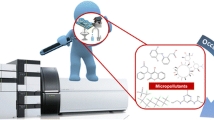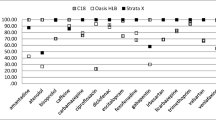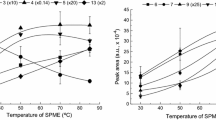Abstract
N-nitrosodimethylamine (NDMA) is one of the most important disinfection by-products (DBPs) due to its carcinogenicity even at low concentrations which correspond to the levels occurring in drinking water and wastewater effluents. Therefore, NDMA is a candidate DBP that is expected to be regulated in the near future. However, the measurement of NDMA in the low nanogram per liter range is challenging because of the limitations of analytical techniques including both the sample preparation and the LC-MS/MS. Moreover, the accuracy of most of the current methods is only tested for drinking water and no information is present for other matrices. In this study, a combination of solid-phase extraction (SPE) and LC-MS/MS method that does not require high-resolution MS or advanced techniques for sample pretreatment is developed. Moreover, important factors that affect the optimization of the SPE method are provided to enable readers to optimize their own SPE procedures if necessary. The proposed method was validated for surface water, groundwater, and wastewater samples and the method quantification limit was 2 ng/L. In addition, the proposed method was used to determine the concentration of NDMA precursors measured as NDMA formation potential (NDMAFP) throughout a drinking water treatment plant at two different sampling periods. NDMAFP decreased by approximately 40 % in both samples. The concentrations ranged between 4 and 11.5 ng/L and the presence of these low concentrations underlines the need for an easy to use, yet sensitive method for the determination of NDMA in environmental matrices.


Similar content being viewed by others
References
Andrzejewski, P., & Nawrocki, J. (2007). N-nitrosodimethylamine formation during treatment with strong oxidants of dimethylamine containing water. Water Science and Technology, 56, 125–131.
Arizona Department of Environmental Quality (ADEQ) (2008). Safe drinking water regulation. http://www.azdeq.gov/environ/water/dw/download/dw_rules.pdf. Accessed 1 Feb 2012.
Asami, M., Oya, M., & Kosaka, K. (2009). A nationwide survey of NDMA in raw and drinking water in Japan. Science of the Total Environment, 407, 3540–3545.
Aygun, S. F., Uyanik, A., & Bati, B. (2004). Adsorption of N-nitrosodiethylamine and N-nitrosodimethylamine on activated carbon: a pre-concentration procedure for gas chromatographic analysis. Microchimica Acta, 146(3–4), 279–283.
California Department of Public Health (CDPH) (2010). Drinking water notification levels and response levels: an overview. http://www.cdph.ca.gov/certlic/drinkingwater/Documents/Notificationlevels/notificationlevels.pdf. Accessed 1 Feb 2012.
California Environmental Protection Agency (CEPA) (2006). Public health goals for chemicals in drinking water: n-nitrosodimethylamine, pesticide and environmental toxicology branch office of environmental health hazard assessment. http://oehha.ca.gov/water/phg/pdf/122206NDMAphg.pdf. Accessed 1 Feb 2012.
Cha, W., Fox, P., & Nalinakumari, B. (2006). High-performance liquid chromatography with fluorescence detection for aqueous analysis of nanogram-level N-nitrosodimethylamine. Analytica Chimica Acta, 566, 109–116.
Charrois, J. W. A., Arend, M. W., Froese, K. L., & Hrudey, S. E. (2004). Detecting N-nitrosamines in drinking water at nanogram per liter levels using ammonia positive chemical ionization. Environmental Science and Technology, 38, 4835–4841.
Charrois, J. W. A., Boyd, J. M., Froese, K. L., & Hrudey, S. E. (2007). Occurrence of N-nitrosamines in Alberta public drinking-water distribution systems. Journal of Environmental Engineering and Science, 6, 103–114.
Cheng, R. C., Hwang, C. J., Andrews-Tate, C., Guo, Y. C., Carr, S., & Suffet, I. H. M. (2006). Alternative methods for the analysis of NDMA and other nitrosamines in water. Journal of American Water Works Association, 98, 82–96.
Grebel, J. E., Young, C. C., & Suffet, I. H. M. (2006). Solid-phase microextraction of N-nitrosamines. Journal of Chromatography. A, 1117, 11–18.
Health Canada (HC) (2010). N-Nitrosodimethylamine (NDMA) in Drinking Water Federal-Provincial-Territorial Committee on Drinking Water. http://www.hc-sc.gc.ca/ewh-semt/alt_formats/hecs-sesc/pdf/consult/_2010/ndma/draft-ebauche-eng.pdf. Accessed 1 Feb 2012.
Hu, R., Zhang, L., & Yang, Z. (2008). Picogram determination of N-nitrosodimethylamine in water. Water Science and Technology, 58, 143–151.
Integrated Risk Information System; United States Environmental Protection Agency (USEPA) (1993). Office of Research and Development (ORD) National Center for Environmental Assessment. http://www.epa.gov/iris/subst/0045.htm. Accessed 1 Feb 2012.
Jiang, W. (2005). Good laboratory practice in analytical laboratory. Journal of American Science, 1, 93–94.
Kodamatani, H., Yamazaki, S., Saito, K., Tomiyasu, T., & Komatsu, Y. (2009). Selective determination method for measurement of nitrite and nitrate in water samples using high-performance liquid chromatography with post-column photochemical reaction and chemiluminescence detection. Journal of Chromatography. A, 1216, 3163–3167.
Kosaka, K., Asami, M., Konno, Y., Oya, M., & Kunikane, S. (2009). Identification of antiyellowing agents as precursors of N-nitrosodimethylamine production on ozonation from sewage treatment plant influent. Environmental Science and Technology, 43, 5236–5241.
Kosaka, K., Fukui, K., Asami, M., & Akiba, M. (2010). Source of N-nitrosodimethylamine in river waters of the upper Tone River basin in Japan. Water Science and Technology, 62, 2550–2557.
Krauss, M., & Hollender, J. (2008). Analysis of nitrosamines in wastewater: exploring the trace level quantification capabilities of a hybrid linear ion trap/orbitrap mass spectrometer. Analytical Chemistry, 80, 834–842.
Mitch, W. A., & Sedlak, D. L. (2002). Formation of N-nitrosodimethylamine (NDMA) from dimethylamine during chlorination. Environmental Science and Technology, 36(4), 588–595.
Mitch, W. A., Sharp, J. O., Trussell, R. R., Valentine, R. L., Alvarez-Cohen, L., & Sedlak, D. (2003a). N-nitrosodimethylamine (NDMA) as a drinking water contaminant: a review. Environmental Engineering Science, 20, 389–404.
Mitch, W., Gerecke, A., & Sedlak, D. (2003b). A N-nitrosodimethylamine (NDMA) precursor analysis for chlorination of water and wastewater. Water Research, 37, 3733–3741.
National Health and Medical Research Council (NHMRC) (2011). Australian Drinking Water Guidelines. http://www.nhmrc.gov.au/guidelines/publications/eh52/. Accessed 12 Jul 2012.
Pehlivanoglu-Mantas, E., Hawley, E. L., Deeb, R. A., & Sedlak, D. L. (2006). Formation of nitrosodimethylamine (NDMA) during chlorine disinfection of wastewater effluents prior to use in irrigation systems. Water Research, 40, 341–347.
Perez-Ruiz, T., Martinez-Lozano, C., Tomas, V., & Martin, J. (2005). Automated solid-phase extraction and high-performance liquid chromatographic determination of nitrosamines using post-column photolysis and tris (2,2-bipyridyl) ruthenium(III) chemiluminescence. Journal of Chromatography. A, 1077, 49–56.
Planas, C., Palacios, O., Ventura, F., Rivera, J., & Caixach, J. (2008). Analysis of nitrosamines in water by automated SPE and isotope dilution GC/HRMS—occurrence in the different steps of a drinking water treatment plant, and in chlorinated samples from a reservoir and a sewage treatment plant effluent. Talanta, 76, 906–913.
Plumlee, M. H., Lopez-Mesas, M., Heidlberger, A., Ishida, K. P., & Reinhard, M. (2008). N-nitrosodimethylamine (NDMA) removal by reverse osmosis and UV treatment and analysis via LC-MS/MS. Water Research, 42, 347–355.
Ripolles, C., Pitarch, E., Sancho, J. V., Lopez, F. J., & Hernandez, F. (2011). Determination of eight nitrosamines in water at the ng/L levels by liquid chromatography coupled to atmospheric pressure chemical ionization tandem mass spectrometry. Analytical Chimica Acta, 702, 62–71.
Schmidt, C. K., & Brauch, H. J. (2008). N, N-dimethosulfamide as precursor for N-nitrosodimethylamine (NDMA) formation upon ozonation and its fate during drinking water treatment. Environmental Science and Technology, 42, 6340–6346.
Taguchi, V., Jenkins, S. D. W., Wang, D. T., Palmentier, J., & Reiner, E. J. (1994). Determination of N-nitrosodimethylamine by isotope-dilution, high-resolution mass-spectrometry. Canadian Journal of Applied Spectroscopy, 39, 87–93.
United States Environmental Protection Agency (USEPA) (2007). Unregulated contaminant monitoring program. http://water.epa.gov/lawsregs/rulesregs/sdwa/ucmr/ucmr2/basicinformation.cfm. Accessed 1 Feb 2012.
United States Environmental Protection Agency (USEPA) (2009). Federal register drinking water contaminant candidate list-3. http://www.epa.gov/fedrgstr/EPA-WATER/2009/October/Day-08/w24287.pdf. Accessed 1 Feb 2012.
Van Huy, N., Murakami, M., Sakai, H., Oguma, K., Kosaka, K., Asami, M., & Takizawa, S. (2011). Occurrenece and formation potential of N-Nitrosodimethylamine in ground water and river water in Tokyo. Water Research, 45(11), 3369–3377.
Wang, W. F., Hu, J. Y., Yu, J. W., & Yang, M. (2010). Determination of N-nitrosodimethylamine in drinking water by UPLC-MS/MS. Journal of Environmental Science-China, 22, 1508–1512.
World Health Organization (WHO) (2011). Guidelines for drinking-water quality fourth edition. http://whqlibdoc.who.int/publications/2011/9789241548151_eng.pdf. Accessed 1 Feb 2012.
Yoon, S., Nakada, N., & Tanaka, H. (2011). Occurrence and removal of NDMA and NDMA formation potential in wastewater treatment plants. Journal of Hazardous Materials, 190, 897–902.
Zhao, Y. Y., Boyd, J., Hrudey, S. E., & Li, X. F. (2006). Characterization of new nitrosamines in drinking water using liquid chromatography tandem mass spectrometry. Environmental Science and Technology, 40, 7636–7641.
Acknowledgments
This work was funded by The Scientific and Technological Research Council of Turkey (TUBITAK, project # 108Y311).
Author information
Authors and Affiliations
Corresponding author
Rights and permissions
About this article
Cite this article
Topuz, E., Aydin, E. & Pehlivanoglu-Mantas, E. A Practical LC-MS/MS Method for the Detection of NDMA at Nanogram per Liter Concentrations in Multiple Water Matrices. Water Air Soil Pollut 223, 5793–5802 (2012). https://doi.org/10.1007/s11270-012-1315-1
Received:
Accepted:
Published:
Issue Date:
DOI: https://doi.org/10.1007/s11270-012-1315-1




